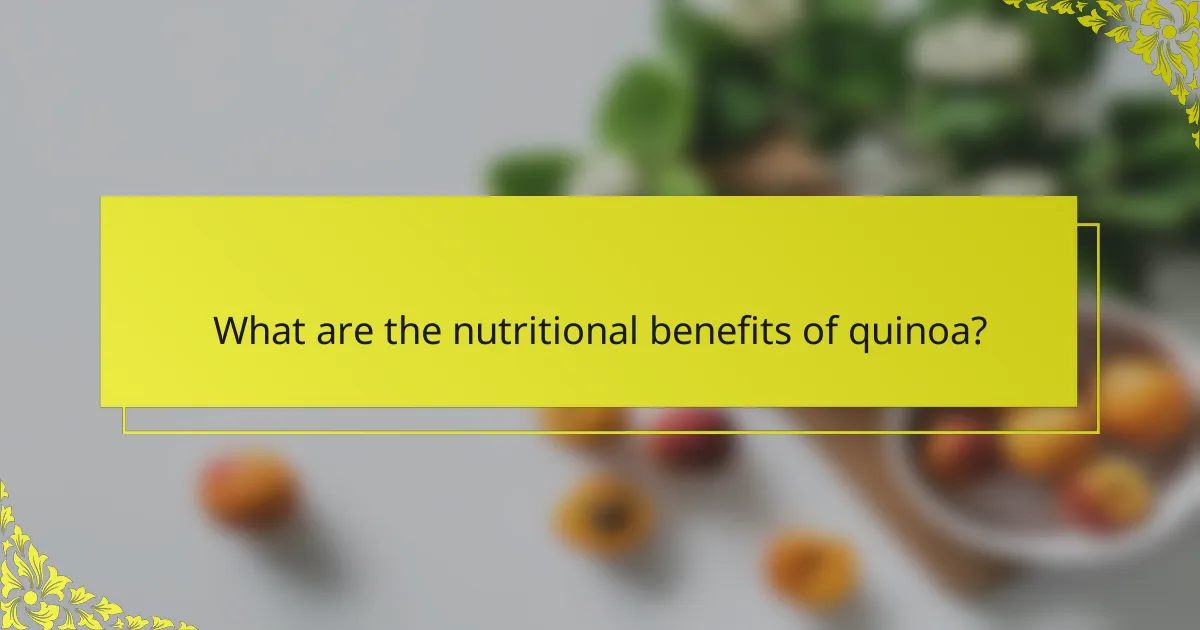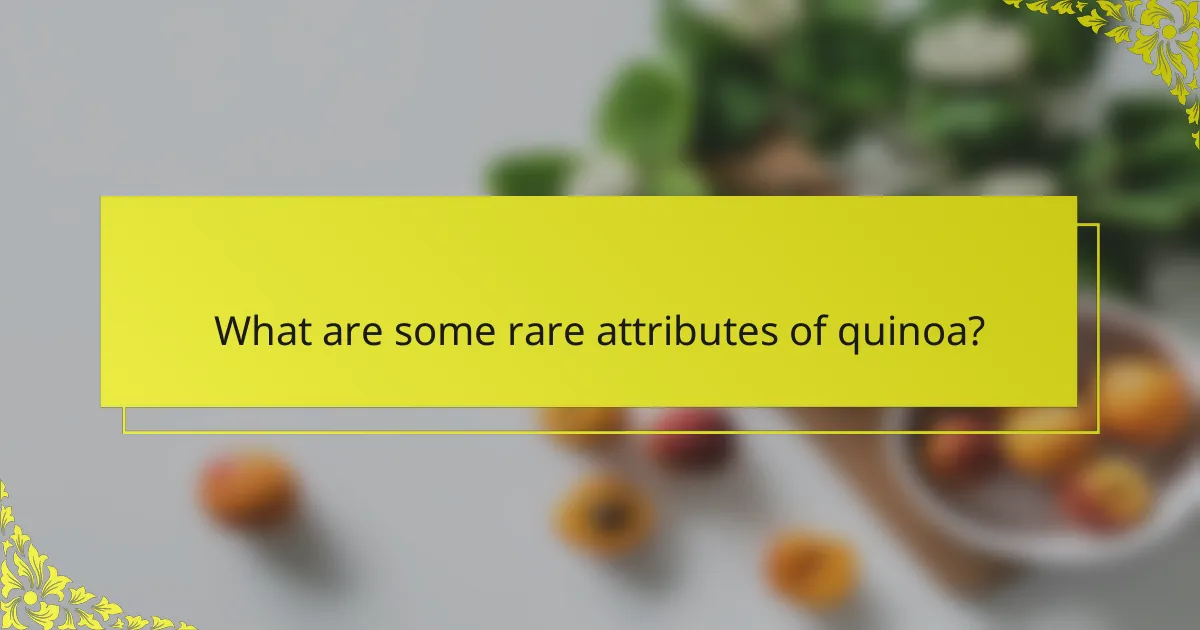Quinoa offers numerous nutritional benefits, making it a valuable addition to any diet. It provides essential amino acids, fibre, and vitamins while being gluten-free. This article explores various cooking methods, including boiling and steaming, to enhance its flavour and texture. Additionally, discover diverse dietary uses for quinoa, from salads to breakfast dishes, that support overall health and nutrition.

What are the nutritional benefits of quinoa?
Quinoa is highly nutritious, offering essential amino acids, fibre, and vitamins. It provides 8 grams of protein per cup, making it a complete protein source. Quinoa is rich in magnesium, iron, and antioxidants, promoting overall health. Its low glycaemic index supports blood sugar control, beneficial for diabetes management.
How does quinoa compare to other grains in terms of protein content?
Quinoa has a higher protein content compared to most grains, averaging about 8 grams of protein per cooked cup. In contrast, brown rice contains approximately 5 grams, while barley has around 3.5 grams. This unique attribute makes quinoa an excellent choice for those seeking plant-based protein sources. Additionally, quinoa is a complete protein, meaning it contains all nine essential amino acids, which is rare among grains.
What vitamins and minerals are abundant in quinoa?
Quinoa is rich in several vitamins and minerals, including magnesium, phosphorus, manganese, and folate. These nutrients contribute to its health benefits, such as supporting bone health and aiding metabolism. Quinoa contains 118 mg of magnesium per cooked cup, which is 30% of the daily recommended intake.
What are the health benefits associated with quinoa consumption?
Quinoa consumption offers numerous health benefits, including improved digestion, weight management, and enhanced heart health. This grain is rich in essential amino acids, fibre, and antioxidants. Quinoa provides a complete protein source, which is rare among plant foods, making it ideal for vegetarians. Its high magnesium content supports muscle function and reduces inflammation. Regular intake may lower cholesterol levels, contributing to cardiovascular health.

What cooking methods are best for preparing quinoa?
The best cooking methods for preparing quinoa include boiling, steaming, and baking. Boiling is the most common method, allowing quinoa to absorb water and become fluffy. Steaming retains more nutrients and enhances flavour. Baking can create a crunchy texture and is often used in recipes like quinoa casseroles. Each method offers unique benefits, making quinoa versatile in various dishes.
How do you cook quinoa on the stovetop?
To cook quinoa on the stovetop, rinse 1 cup of quinoa under cold water. Combine it with 2 cups of water or broth in a saucepan. Bring to a boil, then reduce heat to low, cover, and simmer for 15 minutes until liquid is absorbed. Fluff with a fork before serving. Quinoa is a complete protein, providing all nine essential amino acids, making it a nutritious dietary choice.
What is the water-to-quinoa ratio for perfect cooking?
The ideal water-to-quinoa ratio for perfect cooking is 2:1. This means using two cups of water for every cup of quinoa. Properly measuring this ratio ensures the quinoa cooks evenly and achieves the desired fluffy texture. Quinoa typically takes about 15-20 minutes to cook, absorbing the water fully and expanding in size.
Can quinoa be prepared in a rice cooker?
Yes, quinoa can be prepared in a rice cooker. This method simplifies cooking and ensures even texture. To achieve the best results, rinse quinoa before cooking to remove bitterness. Use a 2:1 water-to-quinoa ratio for optimal consistency. Cooking time typically ranges from 15 to 20 minutes, depending on the rice cooker model. Quinoa is a rich source of protein and fibre, making it a nutritious addition to various dishes.
What are some unique ways to incorporate quinoa into recipes?
Quinoa can be incorporated into recipes in unique ways, such as using it in salads, smoothies, and baked goods. For salads, mix cooked quinoa with fresh vegetables and a tangy dressing for a nutritious meal. In smoothies, blend quinoa with fruits and yoghurt for added protein. Use quinoa flour in baking to enhance the nutritional profile of muffins and bread. Additionally, quinoa can be used as a stuffing for vegetables like bell peppers or courgettes, adding flavour and texture. These methods highlight quinoa’s versatility and nutritional benefits.

What dietary uses does quinoa have?
Quinoa is highly versatile in dietary uses, serving as a gluten-free grain alternative and a protein source. It can be used in salads, soups, and as a side dish. Its unique attribute is a complete protein profile, containing all nine essential amino acids. Additionally, quinoa is rich in fibre, vitamins, and minerals, making it beneficial for digestive health and overall nutrition. As a result, it supports various dietary needs, including vegetarian and vegan diets.
How can quinoa fit into a gluten-free diet?
Quinoa is an excellent choice for a gluten-free diet due to its natural absence of gluten. It provides a complete protein source, containing all nine essential amino acids, making it ideal for those avoiding gluten. Quinoa is also rich in fibre, vitamins, and minerals, enhancing its nutritional profile. Additionally, it can be easily incorporated into various dishes, such as salads, soups, and side dishes, offering versatility in meal planning.
What role does quinoa play in vegetarian and vegan diets?
Quinoa is a vital source of protein and essential nutrients in vegetarian and vegan diets. It provides all nine essential amino acids, making it a complete protein. Additionally, quinoa is rich in fibre, vitamins, and minerals, including magnesium and iron. Its versatility in cooking allows it to be used in salads, bowls, and as a substitute for grains. As a gluten-free option, quinoa accommodates those with dietary restrictions, enhancing its appeal in plant-based nutrition.
How can quinoa be used in meal prepping?
Quinoa can be effectively used in meal prepping due to its versatility and nutritional benefits. It serves as a base for salads, bowls, and sides, providing a complete protein source. Cooked quinoa can be stored in the refrigerator for up to five days, making it convenient for weekly meal planning.
To incorporate quinoa into meal prep, consider these methods:
1. **Cook in bulk**: Prepare a large batch and portion it for various meals.
2. **Mix with vegetables**: Combine with roasted or steamed vegetables for added nutrients.
3. **Flavor variations**: Use different herbs and spices to create diverse flavours.
4. **Incorporate proteins**: Add beans, chicken, or tofu for balanced meals.
5. **Use in breakfast**: Prepare quinoa porridge with fruits and nuts for a nutritious breakfast option.
These approaches enhance meal variety while maximizing the health benefits of quinoa.

What are the unique attributes of quinoa?
Quinoa possesses several unique attributes that set it apart from other grains. It is a complete protein, containing all nine essential amino acids. Quinoa is gluten-free, making it suitable for those with gluten sensitivities. Additionally, it has a low glycaemic index, which aids in blood sugar management. Its rich nutrient profile includes high levels of fibre, magnesium, and antioxidants. Quinoa also has a distinct nutty flavour and a unique texture that adds variety to dishes.
What makes quinoa a complete protein source?
Quinoa is a complete protein source because it contains all nine essential amino acids. This unique attribute makes it particularly beneficial for vegetarians and vegans. Additionally, quinoa is high in fibre, vitamins, and minerals, enhancing its overall nutritional profile. Its versatility in cooking methods allows it to be easily incorporated into various dishes, making it a popular dietary choice.
How does the glycaemic index of quinoa compare to other grains?
Quinoa has a lower glycaemic index compared to many other grains, making it a better choice for blood sugar control. The glycaemic index of quinoa is approximately 53, while grains like white rice can reach up to 73. This unique attribute highlights quinoa’s potential health benefits, especially for individuals managing diabetes or weight. Other whole grains, such as barley and brown rice, have glycaemic indices around 50 to 55, showing that quinoa is competitive in this regard. Overall, quinoa’s nutritional profile and glycaemic index make it a valuable addition to a balanced diet.

What are some rare attributes of quinoa?
Quinoa possesses several rare attributes that distinguish it from other grains. One such unique characteristic is its complete protein profile, containing all nine essential amino acids. Additionally, quinoa is gluten-free, making it suitable for those with gluten sensitivities. Another rare attribute is its high antioxidant content, which includes quercetin and kaempferol, beneficial for reducing inflammation. Lastly, quinoa has a unique saponin coating that can impart a bitter taste if not rinsed properly, but it also serves as a natural pest deterrent in cultivation.
What are the lesser-known varieties of quinoa?
Less-known varieties of quinoa include black quinoa, red quinoa, and rainbow quinoa. Black quinoa has a nutty flavour and retains a crunchy texture after cooking. Red quinoa provides a slightly sweeter taste and is often used in salads. Rainbow quinoa is a blend of different colours, offering visual appeal and a mix of flavours. These varieties contain similar nutritional benefits, including high protein and fibre content, while adding unique attributes to dishes.
How does the cultivation of quinoa impact its nutritional profile?
The cultivation of quinoa enhances its nutritional profile by improving soil quality and promoting biodiversity. Organic farming practices increase nutrient density, leading to higher levels of protein, fibre, and essential vitamins. Additionally, different cultivation methods can influence the presence of unique antioxidants, which contribute to quinoa’s health benefits. For example, varieties grown at higher altitudes often exhibit enhanced amino acid profiles.

What are the best practices for incorporating quinoa into your diet?
Incorporating quinoa into your diet can enhance nutrition and diversify meals. Start by using it as a base for salads, replacing rice in stir-fries, or adding it to soups for extra protein and fibre.
Consider cooking quinoa with vegetable broth for added flavour. Its unique attribute is a complete protein, containing all nine essential amino acids, making it ideal for vegetarians.
Experiment with various cooking methods, such as boiling or steaming, to find your preferred texture. Pair quinoa with vegetables, legumes, or lean proteins to create balanced dishes.
Lastly, remember that quinoa can be used in breakfast dishes, like porridge, providing a nutritious start to your day.
What common mistakes should be avoided when cooking quinoa?
To avoid common mistakes when cooking quinoa, ensure proper rinsing, accurate water ratios, and avoid overcooking. Rinsing removes saponins, which can impart bitterness. A typical water-to-quinoa ratio is 2:1, and overcooking can lead to a mushy texture. Allow quinoa to rest after cooking to enhance fluffiness.
How can you enhance the flavour of quinoa dishes?
To enhance the flavour of quinoa dishes, consider using broth instead of water for cooking. Incorporate aromatic ingredients like garlic, onion, or herbs during cooking. Adding spices such as cumin or paprika can elevate the taste. For a unique twist, mix in citrus zest or a splash of vinegar post-cooking. Finally, topping with fresh herbs or nuts adds texture and flavour.
What tips do experts recommend for storing quinoa?
Experts recommend storing quinoa in a cool, dry place in an airtight container. This method preserves its freshness and prevents moisture absorption. For long-term storage, refrigeration or freezing is advised, as it can extend shelf life significantly. Additionally, labeling containers with the purchase date helps track freshness.




